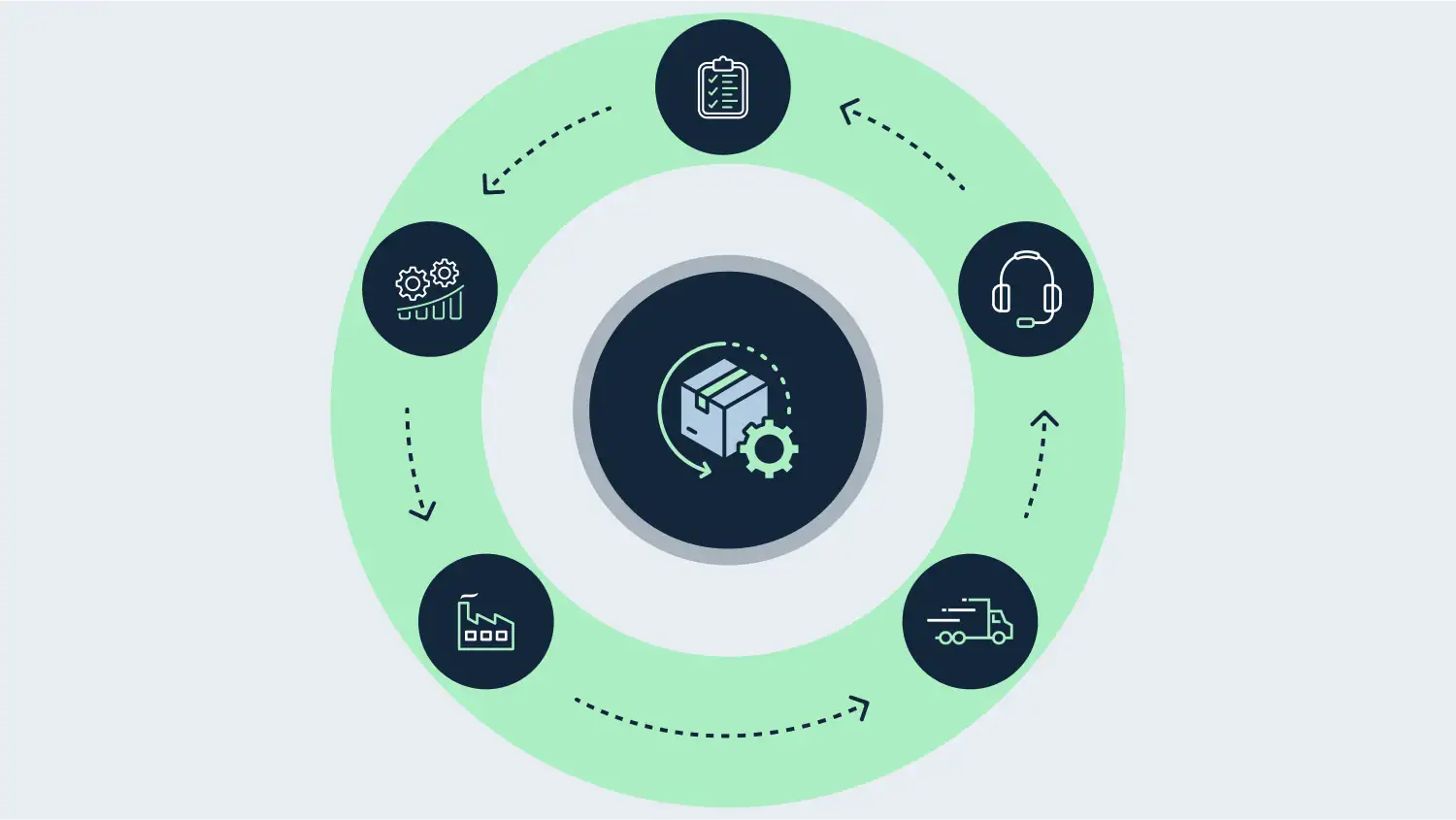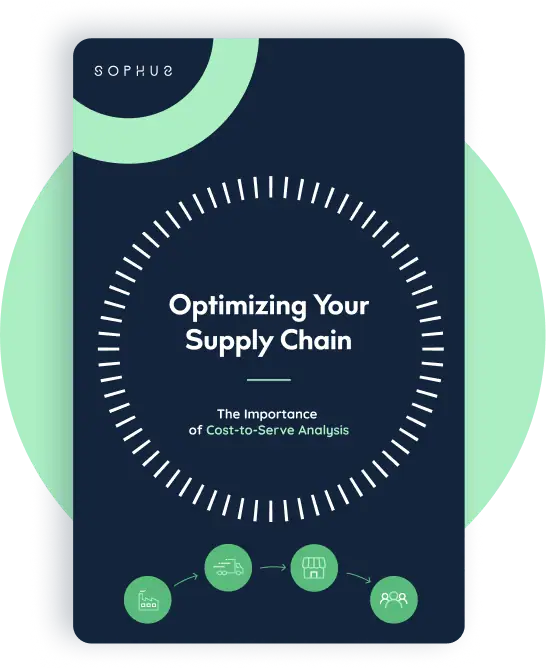Sales and Operations Planning (S&OP) is an important process for businesses that are aiming to align their sales and production efforts. It helps companies to balance their supply and demand by making sure they are using their resources efficiently.
According to McKinsey’s report, companies with effective S&OP processes can see a 15% increase in profitability.
However, managing S&OP processes can be complicated and ineffective for many companies, and they face various challenges. These issues include disconnected data, inaccurate predictions, and siloed planning practices that can diminish profit improvement and increase missed opportunities.
Companies are increasingly adopting optimization techniques to overcome these challenges. By integrating optimization into S&OP, businesses can enhance their collaboration and make better decisions from end to end supply chain perspective, therefore truly unleash the benefits of S&OP and improve margin.
Challenges in Traditional S&OP
Many companies struggle with their Sales and Operations Planning (S&OP) processes. These challenges can lead to inefficiencies and missing opportunities for margin improvements.
Here are some common issues that companies face:
1. Manual S&OP Processes without consideration of cost optimization
As companies use outdated planning systems, lots of the actual sales and operations planning remains largely manual. Created and updated through spreadsheets. Once the plan is finalized, the planners will upload these spreadsheets into the planning systems.
These outdated systems and the manual spreadsheet often focus on getting a plan in place that can be executed within existing limitations.
Therefore, these plans commonly maintain the current way of doing things, such as inventory levels, when and where the production should take place, plant-to-DC allocations, etc.
This approach prevents companies from exploring options to change the current way of thinking, to really consider cost optimization in the planning process
2. Lack of Supply Chain perspective
The traditional S&OP process and planning systems mostly tackle overall planning from a siloed perspective; that is to say, they are designed based on a step-by-step supply chain management process.
Most planning systems and S&OP processes follow a defined sequence, which typically involves:
- Demand Planning: First, you create a plan for how much to sell, which outlines the expected demand.
- Production Planning: Based on the demand plan, you then develop the production plan, detailing how much to produce and when.
- Sourcing Planning: With the production plan in place, you determine the sourcing requirements, specifying how to obtain the necessary materials or components.
- Shipping and Delivery Planning: Finally, once the demand, production, and sourcing plans are established, you plan how to ship and deliver the products to meet customer needs.

Production Planning Perspective
When planning each step, it is from the perspective of how I can fulfill this requirement from a single function perspective.
For example, let’s examine the production plan. Usually, when making a production plan, the demand has already been consolidated to the factory level, so the question here is how best to utilize the factory’s capacity to fulfill the demand.
If the demand exceeds the capacity of the factory or production lines, then a certain volume needs to be allocated to a nearby factory or production line.
Logistics Function and Demand Consolidation
The logic of how demand is consolidated to the factory level is often based on the perspective of the logistics function.
The logistics team would provide the so-called optimal link between the factory and the demand point so that the demand can be aggregated to the factory level.
Limitations of Traditional Approaches
This approach may sound correct and be easily understood, but it is not an end-to-end perspective, and there is huge room for margin improvement.
Why?
When the logistics team allocates demand to the factories, they often focus on the shortest distance or minimize transportation cost.
They do not consider whether the factories or production lines can actually produce the required amount.
Additionally, they might overlook whether it is cost-effective to produce that much, as manufacturing and raw material costs can vary significantly across different factories.
Potential Improvements
If one factory or production line has advantages over others at a given time, more volumes should be allocated to it, even if it means an increase in logistics costs.
Sometimes, allowing those factories or production lines to pre-build inventory is also a good option.
The same logic would apply for any function in the S&OP process whether it is inventory planning, sourcing plan, demand planning.
S&OP Process and Departmental Decisions
The decisions or rules made by each division would impact the overall supply chain cost, but each division would only make such a decision based on its own departmental perspective.
This was how the traditional planning process and the traditional S&OP process were designed: They were targeted for collaboration between departments to achieve an executable plan, not optimization from an end-to-end supply chain perspective to improve margin.
3. Limited Scenario Planning To Adopt to Market Change
Another major challenge is limited scenario planning. Traditional S&OP methods often focus on a single forecast or plan, which can be risky in today’s uncertain business environment.Changes are normal.
According to the publication’s research, supply chains are constantly interrupted because of all kinds of internal and external factors, whether it is competition, recently imposed duty on electric vehicles, or the Red Sea being blocked because of the war.
Companies need more than ever to adapt to alternative scenarios and develop contingency plans to adjust to changing conditions. By preparing for uncertain scenarios, companies can minimize risk and position themselves to take advantage of new opportunities in a dynamic market.
Almost all planning solutions or S&OP processes include a scenario planning capability, but this is often more of a simulation than an optimization. What does this mean?
For example, if a production line is shut down due to a strike, the traditional approach is to see if the next available line can take its place. If that line doesn’t have enough capacity, you then choose the second closest one. This process continues in a similar fashion.
To illustrate: imagine a battlefield where you have deployed numerous fighting units. If one unit is in trouble due to enemy superiority, you pull out a nearby unit to support it. This causes the area from which you pulled the unit to lose ground. You then move to the next unit, and the next, potentially causing the entire battlefield to face difficulties.
Instead, you should assess the overall scenario. Evaluate the entire battlefield to make decisions that minimize the impact on other areas while addressing the critical situation.
From a supply chain perspective, scenario planning should consider the entire supply chain, including its capacities and limitations, to make the most informed decision.
4. Inefficient Resource Allocation
Traditional S&OP methods often struggle with resource allocation. Without proper optimization tools, businesses can find it challenging to manage inventory and supply chain resources effectively. This lack of balance can lead to overproduction or underutilization of assets like labor or materials.
This issue arises because many planning solutions or traditional S&OP processes cannot view supply chain decisions holistically. Instead, they often operate in a siloed manner, considering only parts of the supply chain.
Such inefficiencies can negatively impact a company’s profitability through increased costs or lost revenue opportunities. Efficient resource allocation is crucial to maintaining profitability and ensuring smooth operations without unnecessary waste.
5 Ways to Empower S&OP with Optimization
Achieving long-term success in Sales and Operations Planning (S&OP) requires a clear and structured approach. It involves changing and updating processes, organizations, and supply chain planning and optimization technologies.

Here are some practical ways to enhance S&OP through optimization:
1. Establish the Right Organizational Structure and Roles and Responsibilities
Traditional planning is often done through a team of demand planners, inventory planners, logistics planners, supply planners, etc.
These planners’ roles and responsibilities are actually focused on excellence in their own domain. It is unfair and also difficult for them to bear the responsibility of end-to-end supply chain optimization and cost reduction.
Therefore, another role should be created that is more focused on the end-to-end supply chain optimization perspective to make this work. A collaboration process should be established between this role and all other planning functions.
2. Collaborative Demand Planning
More accurate demand forecasting is undoubtedly very important for efficient and effective S&OP. Marketing and sales teams often work together to identify important market trends that might impact demand and try to come up with a better demand forecast.
Here is how supply chain optimization helps:
Businesses can forecast customer demands using AI-powered sales forecast technology.
This technology can capture the impacting factors that influence the demand forecast and project future demand. It also drives a more informed approach to how much market trend shifts, pricing, promotion, etc., impact demand. This approach will ensure a company is well-prepared to meet customer demands and any upcoming challenges.
3. A Supply Chain Plan made with an end-to-end perspective and cost optimization
An end-to-end supply chain plan that considers not only a single function but also the overall supply chain constraints, such as storage capacity, production capabilities, sourcing constraints, inventory consideration, and logistics limitations.
Consider all these constraints, as well as cost elements such as sourcing, transportation, manufacturing, and even duties and taxes from a finance perspective.
One optimized plan or multiple optimized plans can be created with true consideration from an end-to-end view, and companies can spot challenges like capacity limits, delivery issues, or staffing shortages right away from a holistic point of view.
This plan would also allow companies to understand the driving factors of end-to-end supply chain costs or capacity limitations.
Below is a concept from SCOR-DS that, in a way, puts this end-to-end optimization process into the interesting word “orchestrate,” which is exactly what supply chain optimization technology can enable for planning.
4. Scenario planning from an end-to-end perspective
Optimization technologies would allow the scenario plan to break the silo perspective. Again, put into an analogy – it is like a battlefield; instead of looking into 2 or 3 fighting units, the commander can look into tens of fighting units at the same time and make a coordinated decision on how to deploy the fighting resources to tackle the changing conditions in the battlefield.
Scenario planning through optimization opens doors to truly finding the optimal solution to tackle challenges related to changing conditions in the supply chain. Instead of just moving some pieces around, it is planning from a holistic perspective.
This would make the response to changes and challenges more effective and informed because the challenges are being tackled from an end-to-end optimization perspective.
5. Executive S&OP Meetings
The last step of the S&OP is often the executive S&OP meeting, where the pre-S&OP plan is reviewed. This step ensures the plan aligns with the company’s strategic goals. This meeting analyzes different scenarios and examines key factors that drive value.
Executives can use optimization technology to perform quick analyses and make informed decisions on the spot from a holistic perspective. They can also add cost optimization to the table instead of simply trying to meet demand with supply. They also get access to detailed reports and dashboards so the company stays on track with its long-term objectives.
Sophus S&OP Solution
Sophus offers a reliable solution to enhance companies’ S&OP process with its Proprietary supply chain optimization technology.
It can address the common challenges companies face based on legacy planning systems or S&OP processes And bring more value to companies than ever before.
Let’s look at how Sophus helps companies to enhance their S&OP:
End to end Comprehensive Optimization on your supply chain planning
Sophus’ solution optimizes various aspects of the S&OP process from a holistic point of view. It can consider the constraints and limitations of the supply chain, as well as all elements of cost, at the same time. Then, collectively, it determines what to produce, how much to produce, and when to produce, how much to stock, where to source, how much to source, when to deliver, and how much to deliver in one go.
This approach makes sure that the plan that’s set can meet consumer demand efficiently while minimizing costs.
Integrated and single point of truth
One of the key reasons why lots of the plans are still done manually today and then uploaded into planning systems merely for execution is because of the huge amount of disconnected data across different planning functions.
Sophus offers a unified data model for end-to-end supply chain optimization. This unified data model can integrate with varying planning systems and provide a single point of truth, streamline the S&OP process, and reduce complexity.
Teams can make better decisions based on accurate and up-to-date information when they have a single source of truth.
Real-Time What-If Scenario Building
The platform includes real-time what-if scenario capabilities. This feature helps companies evaluate different planning scenarios quickly. It also lets companies explore various options for production and inventory optimization while considering the entire supply chain.
This flexibility helps teams adapt to market changes and make informed decisions.
Enhanced Resource Utilization
Sophus Technology helps businesses better use their resources. Companies can avoid waste by optimizing production plans and inventory levels and improving overall performance in one go. This leads to better customer satisfaction and a stronger competitive edge.
Benefits Integrated S&OP enhanced by Optimization powered by Sophus
Integrated S&OP enhanced by Optimization can really offer various benefits for companies looking to improve their balance sheet. Here are some key advantages:
- Cost Savings: Sophus helps businesses reduce variable production costs by up to 6-8%. This is achieved through an integrated S&OP process enhanced by Supply Chain Optimization capability. The platform also enables 8-10% logistics cost reductions while improving production and inventory at the same time.
- Improved Capacity Utilization: Sophus helped companies to improve capacity utilization by 35-40% by optimizing the overall supply chain plan and a better resource allocation. This makes sure that companies are making the best use of their available resources that leads to better productivity.
- Enhanced Flexibility: The platform’s real-time what-if scenario-building capabilities help companies to quickly adapt to changing market conditions. Teams can evaluate different planning scenarios and make informed decisions from a holistic point of view.
Ready to Supercharge Your S&OP? Explore the Power of Sophus
Don’t settle for the limitations of traditional S&OP. Sophus offers a revolutionary approach that can transform your planning process and unlock significant benefits.
With proprietary optimization technology, real-time data integration into a single data model, and powerful predictive analytics, Sophus can help you optimize your S&OP process and drive better business outcomes.
Use the analogy of battlefield again, you have a command system in place and a control tower to oversee and plan in real time, but now you enhance it with a battlefield simulation and deployment optimization capability that allow simulation of different what-ifs and optimize your plan so as to increase the odds of winning.
Visit Sophus today to learn more about how their solution can:
- Slash costs with optimized production, inventory, and logistics.
- Boost agility with data-driven scenario planning and real-time insights.
- Make smarter decisions with automated recommendations and a unified view of your business.
Take control of your S&OP and ensure a future of growth and efficiency. Schedule a demo with Sophus X to see the difference.









